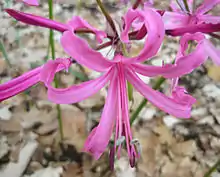Nerine bowdenii
Nerine bowdenii is a species of flowering plant in the family Amaryllidaceae. It is an herbaceous bulbous perennial, growing to 45 cm (18 in) tall by 8 cm (3 in), with strap-shaped leaves and large umbels of lily-like pink flowers in late summer and autumn.[1] The common names of the species are Cornish lily, Cape flower, Guernsey lily, and Bowden lily. However, it is neither a true lily nor from Cornwall or Guernsey, but originates from South Africa (Eastern Cape, KwaZulu Natal, Free State, Drakensberg Mountains).[1] Confusingly the name “Guernsey lily” is also applied to a related species, Nerine sarniensis.
| Nerine bowdenii | |
|---|---|
 | |
| Scientific classification | |
| Kingdom: | Plantae |
| Clade: | Tracheophytes |
| Clade: | Angiosperms |
| Clade: | Monocots |
| Order: | Asparagales |
| Family: | Amaryllidaceae |
| Subfamily: | Amaryllidoideae |
| Genus: | Nerine |
| Species: | N. bowdenii |
| Binomial name | |
| Nerine bowdenii | |
The species was named in 1904 after Athelstan Cornish-Bowden who had sent bulbs of the plant to England from South Africa.[2][3][4]
Description
N. bowdenii bulbs are 12 to 14 centimetres (4.7 to 5.5 in) in circumference.[5] The bulbs are "shaped like old-fashioned Chianti bottles".[4] The plant has eight or more faintly-scented bright pink flowers with frilly tips, resembling finely-cut lilies.[6] Because the leaves do not appear until spring, the species can tolerate lower temperatures than most species in the genus Nerine.[7]
Cultivation
Nerine bowdenii is widely cultivated in temperate regions, where it requires warmth and shelter in colder areas, but is quite hardy, being able to withstand temperatures of −15 °C (5 °F).[4] It needs to be planted where it cannot be disturbed for several years, and blooms best when the bulbs are crowded. The species grows best in heat and well-drained soil.[8] However, it will not tolerate tropical or very humid weather.[9][10] It is suggested that colchicums and cyclamens are good choices of companion plants to grow with this species.[4]
Cultivars
The following cultivars have won the Royal Horticultural Society's Award of Garden Merit:-
Biochemistry
The bulbs of Nerine bowdenii contain ungeremine, a betaine-type alkaloid, and a number of other alkaloids.[16] Ungeremine is an inhibitor of acetylcholinesterase, and as such may be of interest in research into treatment of Alzheimer's disease. Ungeremine also has been isolated from a number of related plant species, such as Ungernia minor, Ungernia spiralis, Zephyranthes flava, Crinum asiaticum, Crinum augustum, Pancratium maritimum and Hippeastrum solandriflorum.[17]
Diseases
The plant virus, vallota mosaic virus, has been found to infect Nerine bowdenii and other members of the genus Nerine in the UK.[18]
See also
References
| Wikimedia Commons has media related to Nerine bowdenii. |
- RHS A-Z encyclopedia of garden plants. United Kingdom: Dorling Kindersley. 2008. p. 1136. ISBN 978-1405332965.
- Watson, W. (26 November 1904). "Nerine bowdenii". The Gardeners' Chronicle. 36 third series: 365.
- David, John (26 October 2007), "The Nerine bowdenii story" (PDF), Report of the Proceedings of Hardy Nerine Study Day, RHS Herbaceous Plant Committee and the Nerine & Amaryllid Society
- Rees, Alun (12 November 2013). "How to grow: Nerine bowdenii". Telegraph.co.uk. Retrieved 24 September 2016.
- "Nerine bowdenii". Holland Technical Service Bulletin. Archived from the original on 2009-11-25. Retrieved 2010-02-08.
- Will, Giles (2007). Encyclopedia of exotic plants for temperate climates. Timber Press. p. 134. ISBN 978-0-88192-785-6.
- Burke, Don (2005). The complete Burke's backyard: the ultimate book of fact sheets. Murdoch Books. p. 231. ISBN 978-1-74045-739-2.
- Easton, Valorie; Hartlage, Richard (2002). Plant Life: Growing a Garden in the Pacific Northwest. Sasquatch Books. p. 199. ISBN 978-1-57061-305-0.
- Urquhart, Paul (2004). Growing Bulbs. Murdoch Books. p. 225. ISBN 978-1-74045-520-6.
- Raven, Sarah (2001). The bold and brilliant garden. frances lincoln ltd. p. 151. ISBN 978-0-7112-1752-2.
- "Nerine bowdenii". www.rhs.org. Royal Horticultural Society. Retrieved 3 January 2021.
- "Nerine bowdenii 'Isabel'". RHS. Retrieved 18 January 2021.
- "Nerine bowdenii 'Quinton Wells'". RHS. Retrieved 18 January 2021.
- "Nerine bowdenii 'Stefanie'". RHS. Retrieved 18 January 2021.
- "Nerine 'Zeal Giant'". RHS. Retrieved 18 January 2021.
- Lyle, R. E.; E. A. Kielar; J. R. Crowder; W. C. Wildman (1960). "The Alkaloids of Nerine bowdenii W. Wats. and Crinum moorei J. D. Hook". Journal of the American Chemical Society. 82 (10): 2620–2625. doi:10.1021/ja01495a057.
- Rhee IK, I; Appels N; Hofte B; Karabatak B; Erkelens C; Stark LM; Flippin LA; Verpoorte R (November 2004). "Isolation of the Acetylcholinesterase Inhibitor Ungeremine from Nerine bowdenii by Preparative HPLC Coupled On-Line to a Flow Assay System". Biological & Pharmaceutical Bulletin. 27 (11): 1804–1809. doi:10.1248/bpb.27.1804. PMID 15516727.
- Monger, W. A.; R. A. Mumford (18 July 2008). "Vallota mosaic virus infecting nerine in the UK". Plant Pathology. 57 (4): 768. doi:10.1111/j.1365-3059.2008.01850.x. Archived from the original on 5 January 2013.